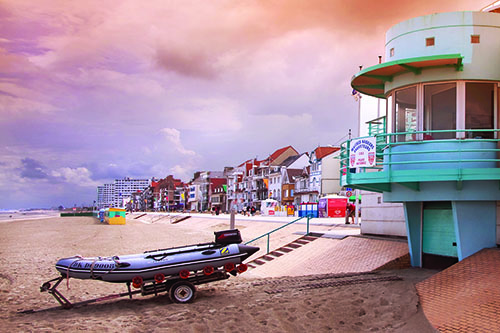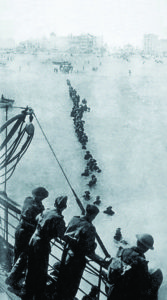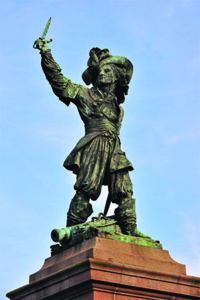
At first blush, the city of Dunkirk seems like many others in modern-day France: young immigrants mix with locals at the graffiti-covered bus shelter while an elderly couple strolls by, holding hands. Motorbikes whizz along wide, modern roads lined with sleek new buildings. Above, billowy white clouds glide in from the English Channel and the high-pitched squawks of seagulls fill the chilly air.
The beach, just 47 miles across the Channel from Dover, England, is lined with restaurants and upscale apartments. Relaxed tourists and the thrum of everyday life make the nightmarish events of May-June 1940 seem far away. It’s easy to forget that a scene of hellish destruction and profound bravery played out here, culminating in a rescue operation that was, in British prime minister Winston Churchill’s words, “a miracle of deliverance.”
As the German army swept across France in the summer of 1940, Allied forces, including the British Expeditionary Force (BEF) and thousands of French, Belgian, Polish, and Dutch troops, fought to repel the onslaught. On May 21, the Allies’ worst fears were realized when the BEF found itself cornered in this pleasant seaside city, once one of the largest ports in France. German forces pummeled the town with high-explosive shells, killing 1,000 civilians on the first day alone, and trapping more than 350,000 Allied troops on a narrow strip of land along the cold waters of the Channel.
With the capture or annihilation of the BEF imminent, the Royal Navy hatched a daring plan borne of desperation. The British government called upon captains of private ships to participate in a dangerous cross-Channel evacuation attempt codenamed Operation Dynamo. Thousands answered the call to duty. Many were untrained volunteers who would sail their vessels directly into German-held territory. Along with about 200 naval ships, more than 700 private vessels participated in the operation, including ferries, paddle steamers, and lifeboats. British admiralty requisitioned some of these vessels, employing volunteers and naval personnel to help man the ships. Private owners and their crew manned others—untested in battle but eager to help in their nation’s hour of danger. The private flotilla came to be known as the “Little Ships of Dunkirk.” The operation’s chances of success were so low, British officials declared a national day of prayer on the eve of the operation, with King George VI attending a special service in Westminster Abbey.
From May 26 to June 4, the 900-strong armada approached the shore under withering enemy fire, as dogfights between Luftwaffe and Royal Air Force fighters raged above. From the sea, the Little Ships’ crews could see fire and smoke rising from the wrecked town and beach as they closed in on France. German strafing kicked up plumes of sand and seawater around them, shredding ships and men alike. About two-thirds of British troops had sought shelter at the mouth of the port, while others waited several hours for rescue in shoulder-deep water. Each boat filled to capacity; most private vessels delivered troops to larger Royal Navy vessels waiting offshore, while others raced home to ports like Dover and Ramsgate to deposit their charges before returning for another run.

By the ninth and final day, around 338,200 Allied troops were safely in England or at friendly French ports. But losses were heavy. Over 200 Allied vessels had been sunk and 145 RAF aircraft were downed. A total of 68,000 British troops were killed, wounded, missing, or captured.
Leveraging the evacuation to great propagandistic effect, Churchill rallied the nation, inspiring a resolve
“to ride out the storm of war, and to outlive the menace of tyranny, if necessary for years, if necessary alone.” That indomitable will to prevail has become enshrined in Britain’s national lore as the “Dunkirk spirit.”
Dunkirk, however, was reduced to a smoking ruin and remained in German hands until war’s end.
Strolling the town center on a blustery October day, I spot a group of older men in tweed jackets gripping cameras and English-language maps. Dunkirk is a popular location for English tourists curious to see where granddad cheated death. In a plaza beside the beautifully rebuilt Saint-Éloi Church is a statue of local hero Jean Bart, a swashbuckling seventeenth-century ship captain and privateer who scored numerous naval victories against the English and Dutch navies and helped save France from famine by capturing dozens of ships carrying Spanish wheat.

Nearby, a soaring belfry, once part of a long-gone church, houses a tourist information office. A memorial across from the church commemorates the evacuation, as do a few plaques scattered about town. But there is little left to directly remind one of the war. Ironically, as in so many other European towns and cities, the most insistent reminder of the war is the relative newness of the place, a consequence of the extensive rebuilding that damage from the war necessitated.
Wanting to escape the busy main road, I follow the briny smell of the southern breeze and find the port. It’s quiet, with vacant pleasure craft calmly bobbing.
Tempted as I am to have a drink near the shore, I have an appointment to keep. Nearby, next to a tall, grassy hill is the Dunkirk 1940 Museum, a low concrete fortress located in the former headquarters of the French and Allied forces during the battle. Inside, the museum director, Lucien, offers me a tour. He explains that the museum is closed for renovations to enlarge the facility, but graciously opened it for my brief afternoon tour so I could get a better perspective of the battle and its aftermath. The renovations will accommodate the increased crowds expected when Dunkirk, a big-budget film on Operation Dynamo by Hollywood director Christopher Nolan, is released in July (see World War II’s interview with Nolan here).
I’m guided past exhibits ranging from helmets to vehicles to bullets—all recovered from the nearby beach. The items lend weight to the events mentioned on the plaques around town and tell stories of ferocious combat. Lucien describes the desperate circumstances of the battle and the destruction of the city in vivid detail, showing the weapons and gear used by both sides. Enormous machine guns, broken bits of aircraft, and the jagged metal of shell casings highlight the danger of the conflict.
Following the war, city planners invited architects from across Europe to help rebuild a shattered Dunkirk. The British government commissioned the construction of wide streets to accommodate cars, as well as the rebuilding of homes and the Saint-Éloi Church. The port reopened and industry returned.
Later, ending my day at a café on the historic beach, I think of the stories I heard at the museum and marvel at the magnitude of the operation that took place here. I wonder at the bravery of the ship captains, military or civilian, who sailed their vessels into harm’s way.
I raise a glass to them and to the cold, soaked soldiers they pried from this small strip of land. Saved by the courage of strangers, the soldiers lived to fight another day. Four years later, they returned to another beach not far awayin Normandy and began the liberation of Europe with the “Dunkirk spirit” burning in their hearts. ✯
Dunkirk is on the Channel coast of northern France, about 150 miles north of Paris and only 6 miles west of the Belgian border. Access is easiest by public transportation or car, and there is plenty of public parking next to the church and the beach. The Dunkirk museum, Musée Dunkerque 1940 (dynamo-dunkerque.com/en/), is located at Courtines du Bastion 32, Rue des Chantiers de France, 59140; currently closed, it will reopen in July. Admission is 5 euros per adult, 4 euros for students, and free for children.
WHERE TO STAY AND EAT
Dunkirk boasts several comfortable hotels with ample amenities. Hotel Borel (www.hotelborel.fr) is near the port with easy access to downtown restaurants and bars. For those traveling to or from England, All Suites Appart Hotel Dunkerque (www.allsuites-apparthotel.com) has cozy apartment-style rooms and is a convenient 15-minute drive to the Dunkirk ferry. Or consider staying across the Belgian border in the lovely medieval town of Bruges, which has the cobbled ambiance Dunkirk lacks. It’s an easy one-hour drive up the E40.
As expected of a port city, there’s plenty of good seafood to be had. L’Estouffade is revered around town; located at 2 Quai Citadelle, it offers a fine menu of fish dishes with savory sauces and well-prepared beef. La Moule Rit (lamoulerit.com) offers fantastic mussels near the seaside, or enjoy a cold brew at the beachfront gastropub La Cocotte (lacocottedk.fr).





